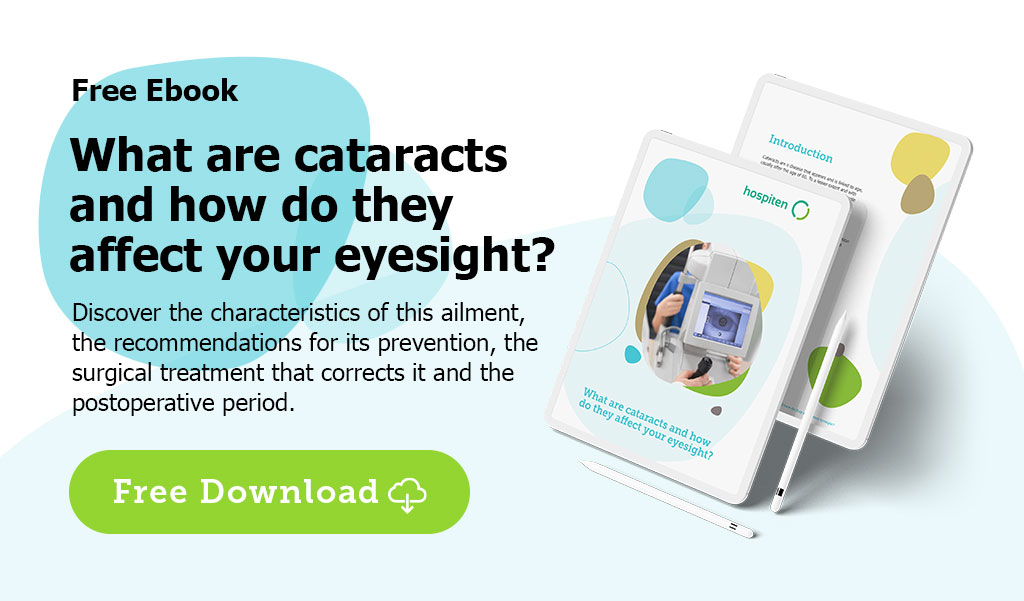Cataracts are an eye condition that occurs because the crystalline lens loses transparency and becomes opaque, making vision difficult, dulling colors and complicating daily activities like reading or driving.
If you are over 60, you are more likely to have age-related cataracts. However, you should not forget that there may be other origins as there is more than one cause for the condition.
Types of cataract according to their origin
Senile cataracts are a result of natural aging, usually after 65 years of age. The lens becomes opaque over time as small particles adhere to its surface.
It is impossible to predict appearance of cataracts or prevent them, although healthy lifestyle habits can delay it. Vision loss due to this type of cataract occurs gradually. The process is progressive, over an extended period of time and does not cause aggressive, immediate blindness.
If there is a history of cataracts in the family, the chances of suffering from senile cataracts are increased due to a person’s genetic load.
This type of cataract develops from a metabolic disease that affects eye health. One of the most common diseases linked to the appearance of metabolic cataracts is diabetes mellitus. One of the symptoms of the disease is that it produces spot-like opacities at both ends.
Congenital cataracts are those that are present from birth. Instead of being born with healthy, transparent lenses, people who suffer from congenital cataracts find themselves with an opaque lens, which does not allow light to enter and therefore makes vision difficult. Although there is no defined cause for the appearance of this type of cataract and the chances of suffering from them are quite low, it has been determined that they may be linked to diseases congenital rubella, trisomy 13, trisomy 21, hereditary congenital cataracts or ectodermal dysplasia syndrome among others.
This type of cataract is linked to serious trauma to the eye. On occasion, the impact of trauma is such that other ocular structures may be damaged. After a hard blow it is important to be vigilant in case there is a loss of visual acuity.
The appearance of traumatic cataracts is not usually immediate, it can take some time for symptoms to appear.
Traumatic cataracts with the worst prognosis are those involving a puncture wound or where the eyeball itself has been affected. In these diagnoses, successful surgery is complicated.
Toxic cataracts are the result of long-term exposure to certain drugs or toxins, the most common of which is corticosteroids. This type of medication can pose a serious risk that cataracts will form at some time during the year following the intensive intake of the medication.

Types of cataract according to the way they form
Depending on where opacity occurs on the lens, there are at least 3 different types of cataract. Each has particular symptoms and form differently.
With nuclear cataracts the accumulation of tissue concentrates in the center of the lens. The condition is usually accompanied by a high degree of myopia and sometimes brings about an improvement in the patient’s ability to read. This type of cataract is closely associated with advanced age. They usually develop gradually and as the lens becomes more opaque symptoms intensify, with blurred vision, loss of perception of brightness, color, etc.
Cortical cataracts begin with cloudiness on the outside or edges of the lens. The accumulation of tissue is usually wedge-shaped or in striae, and little by little they cover the entire lens, with the consequent reduction in light getting through the lens and associated loss of vision. Cortical cataracts mostly affect near vision.
- Posterior subcapsular cataracts
These cataracts occur at the back of the lens, with a cloudy, or opaque area making it difficult for light to get through and they are linked to problems reading, the appearance of halos around lights and bright objects and reduced vision in brightly lit environments. Posterior subcapsular cataracts evolve more rapidly than other types. They can be detected with certain ease because their main symptom is that the patient is sensitive to glaring lights.
Factors that may lead to cataracts
Some factors increase the chances of suffering cataracts, among the most prominent are:
- Aging
- High blood pressure and cholesterol
- Obesity
- Smoking
- Consumption of alcohol
- Sedentary lifestyle
- Unhealthy diet
- Diabetes
- Excessive exposure to sun
- Prior eye surgery
Cataract Treatment
For the removal of cataracts and the recovery of visual acuity, outpatient surgery is necessary, where the ophthalmological surgery team removes the damaged lens replacing it with a synthetic lens that will perform the same function as the natural lens
This procedure is minimally invasive with a straightforward recovery period and a very high level of satisfaction.
The replacement of the crystalline lens with an artificial lens ensures that primary cataracts do not reappear in the patient's life. The capsular bag will cloud over time, this is known as a secondary cataract, and it is easily taken care of with YAG laser treatment in an ophthalmology consultation in just a couple of minutes.
Post-surgery care is simple and standard medical treatment includes antibiotic and anti-inflammatory drops.
There are several ways to approach this surgery and a variety of types of lenses, some of which allow the other eye conditions like astigmatism or presbyopia to be corrected
If you think you may suffer from cataracts, it is important you go to an ophthalmologist to have your visual health checked and a concise, accurate diagnosis made.
